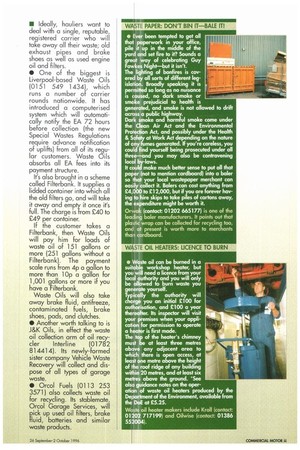• Ever been tempted to get all that paperwork in
Page 53

If you've noticed an error in this article please click here to report it so we can fix it.
your office, pile it up in the middle of the yard and set fire to it Sounds a great way of celebrating Guy Fawkes Night—but it isn't. The lighting of bonfires is covered by all sorts of different legislation. Broadly speaking it is permitted so long as no nuisance is caused, no dark smoke or smoke prejudicial to health is generated, and smoke is not allowed to drift across a public highway. Dark smoke and harmful smoke come under the Clean Air Act and the Environmental Protection Act, and possibly under the Health & Safety at Work Act depending on the nature of any fumes generated. If you're careless, you could find yourself being prosecuted under all three—and you may also be contravening local by-laws. It could make much better sense to put all that paper (not to mention cardboard) into a baler so that your local wastepaper merchant can easily collect it. Balers can cost anything from £4,000 to £12,000, but if you are forever having to hire skips to take piles of cartons away, the expenditure might be worth it.
Onvok (contact 01202 665177) is one of the leading baler manufacturers. It points out that pla ;tic wrap can be collected for recycling too, and at present is worth more to merchants than cardboard.
IN STE OIL HEATERS: UCENCE TO BURN • Waste oil can be burned in a suitable workshop heater, but you will need a licence from your local authority and you will only be allowed to burn waste you generate yourself. Typically the authority will charge you an initial £100 for authorisation, and £100 a year thereafter. Its inspector will visit your premises when your application for permission to operate a heater is first made.
The top of the heater's chimney must be at least three metres above any adjacent area to which there is open access, at least one metre above the height of the roof ridge of any building within 20 metres, and at least six metres above the ground. 'See also guidance notes on the operation of waste oil heaters produced by the Deaartment of the Environment, available from the DoE at £5.25.
Was oil heater makers include Kroll (contact: 01202 717199) and Oilwise (contact: 01386 552004).








































































































































